Sintashta culture
The Sintashta culture[lower-alpha 1] is a Middle Bronze Age archaeological culture of the Southern Urals, dated to the period c. 2200–1750 BCE.[1][2] It is the first phase of the Sintashta–Petrovka complex,[3][4] c. 2200–1750 BCE. The culture is named after the Sintashta archaeological site, in Chelyabinsk Oblast, Russia, and spreads through Orenburg Oblast, Bashkortostan, and Northern Kazakhstan. The Sintashta culture is thought to represent an eastward migration of peoples from the Corded Ware culture. It is widely regarded as the origin of the Indo-Iranian languages[5][6] (Indo-Iranic languages in non-ambigious terms[7][8]), whose speakers originally referred to themselves as the Arya.[9][10] The earliest known chariots have been found in Sintashta burials, and the culture is considered a strong candidate for the origin of the technology, which spread throughout the Old World and played an important role in ancient warfare.[11][12][13][14] Sintashta settlements are also remarkable for the intensity of copper mining and bronze metallurgy carried out there, which is unusual for a steppe culture.[15] Among the main features of the Sintashta culture are high levels of militarism and extensive fortified settlements, of which 23 are known.[16]
 | |
| Period | Late Middle Bronze Age |
|---|---|
| Dates | 2200–1750 BCE |
| Type site | Sintashta |
| Major sites | Sintashta Arkaim Petrovka |
| Characteristics | Extensive copper and bronze metallurgy Fortified settlements Elaborate weapon burials Earliest known chariots |
| Preceded by | Corded Ware culture Poltavka culture Abashevo culture |
| Followed by | Andronovo culture, Srubnaya culture, Vedic culture |
| Part of a series on |
| Indo-European topics |
|---|
 |
Origin
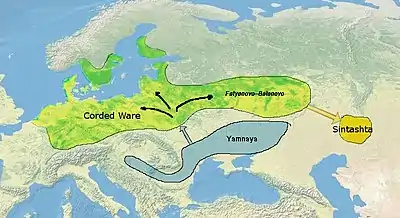
Because of the difficulty of identifying the remains of Sintashta sites beneath those of later settlements, the culture was only distinguished in the 1990s from the Andronovo culture.[17] It was then recognised as a distinct entity, forming part of the "Andronovo horizon".[4] Koryakova (1998) concluded from their archaeological findings that the Sintashta culture originated from the interaction of the two precursors Poltavka culture and Abashevo culture. Allentoft et al. (2015) concluded from their genetic results that the Sintashta culture should have emerged from an eastward migration of peoples from the Corded Ware culture.[18] In addition, Narasimshan et al. (2019) cautiously cite that "morphological data has been interpreted as suggesting that both Fedorovka and Alakul’ skeletons are similar to Sintashta groups, which in turn may reflect admixture of Neolithic forest HGs and steppe pastoralists, descendants of the Catacomb and Poltavka cultures." [19]
Sintashta emerged during a period of climatic change that saw the already arid Kazakh steppe region become even colder and drier. The marshy lowlands around the Ural and upper Tobol rivers, previously favoured as winter refuges, became increasingly important for survival. Under these pressures both Poltavka and Abashevo herders settled permanently in river valley strongholds, eschewing more defensible hill-top locations.[20]
Its immediate predecessor in the Ural-Tobol steppe was the Poltavka culture, an offshoot of the cattle-herding Yamnaya horizon that moved east into the region between 2800 and 2600 BCE. Several Sintashta towns were built over older Poltavka settlements or close to Poltavka cemeteries, and Poltavka motifs are common on Sintashta pottery.[21]
Sintashta material culture also shows the influence of the late Abashevo culture, derived from the Fatyanovo-Balanovo culture, a collection of Corded Ware settlements in the forest steppe zone north of the Sintashta region that were also predominantly pastoralist.[21]
Chronology
Radiocarbon dating indicates that the Sintashta culture dates to between c. 2200 and 1750 BCE,[22][2][23] roughly contemporary with the associated Abashevo and Petrovka cultures.[22][23][24] Some authors date the Petrovka culture slightly later, from c. 1900 BCE.[23][25]
Chariots appear in southern Trans-Urals region in middle and late phases of the culture, c. 2050-1750 BC.[26]
Society
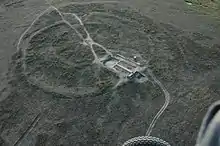
Sintashta settlements are estimated to have a population of between 200 and 700 individuals[27] with economies that "heavily exploited domesticated cattle, sheep, and goats alongside horses with occasional hunting of wild fauna".[28]
Linguistic identity
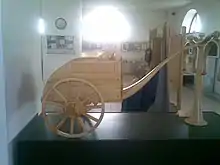
Anthony (2007) assumes that probably the people of the Sintashta culture spoke "Common-Indo-Iranian". This identification is based primarily on similarities between sections of the Rig Veda, a religious text which includes ancient Indo-Iranian hymns recorded in Vedic Sanskrit, and the funerary rituals of the Sintashta culture as revealed by archaeology.[6] Some cultural similarities with Sintashta have also been found to be common with the Nordic Bronze Age of Scandinavia.[29]
There is linguistic evidence of interaction between Finno-Ugric and Indo-Iranian languages, showing influences from the Indo-Iranians into the Finno-Ugric culture.[30][31]
From the Sintashta culture the Indo-Iranian followed the migrations of the Indo-Iranians to Anatolia, the Iranian plateau and the Indian subcontintinent.[32][33] From the 9th century BCE onward, Iranian languages also migrated westward with the Scythians back to the Pontic steppe where the proto-Indo-Europeans came from.[33]
Warfare
The preceding Abashevo culture was already marked by endemic intertribal warfare;[34] intensified by ecological stress and competition for resources in the Sintashta period. This drove the construction of fortifications on an unprecedented scale and innovations in military technique such as the invention of the war chariot. Increased competition between tribal groups may also explain the extravagant sacrifices seen in Sintashta burials, as rivals sought to outdo one another in acts of conspicuous consumption analogous to the North American potlatch tradition.[20]
Sintashta artefact types such as spearheads, trilobed arrowheads, chisels, and large shaft-hole axes were taken east.[35] Many Sintashta graves are furnished with weapons, although the composite bow associated later with chariotry does not appear. Higher-status grave goods include chariots, as well as axes, mace-heads, spearheads, and cheek-pieces. Sintashta sites have produced finds of horn and bone, interpreted as furniture (grips, arrow rests, bow ends, string loops) of bows; there is no indication that the bending parts of these bows included anything other than wood.[36] Arrowheads are also found, made of stone or bone rather than metal. These arrows are short, 50–70 cm long, and the bows themselves may have been correspondingly short.[36]
Sintashta culture, and the chariot, are also strongly associated with the ancestors of modern domestic horses, the DOM2 population. DOM2 horses originated from the Western Eurasia steppes, especially the lower Volga-Don, but not in Anatolia, during the late fourth and early third millennia BCE. Their genes may show selection for easier domestication and stronger backs.[37]
Metal production
| External video | |
|---|---|
The Sintashta economy came to revolve around copper metallurgy. Copper ores from nearby mines (such as Vorovskaya Yama) were taken to Sintashta settlements to be processed into copper and arsenical bronze. This occurred on an industrial scale: all the excavated buildings at the Sintashta sites of Sintashta, Arkaim and Ust'e contained the remains of smelting ovens and slag.[20] Around 10% of graves, mostly adult male, contained artifacts related to bronze metallurgy (molds, ceramic nozzles, ore and slag remains, metal bars and drops). However, these metal-production related grave goods rarely co-occur with higher-status grave goods. This likely means that those who engaged in metal production were not at the top of the social-hierarchy, even though being buried at a cemetery evidences some sort of higher status.[38]
Much of Sintashta metal was destined for export to the cities of the Bactria–Margiana Archaeological Complex (BMAC) in Central Asia. The metal trade between Sintashta and the BMAC for the first time connected the steppe region to the ancient urban civilisations of the Near East: the empires and city-states of modern Iran and Mesopotamia provided a large market for metals. These trade routes later became the vehicle through which horses, chariots and ultimately Indo-Iranian-speaking people entered the Near East from the steppe.[39][40]
Gallery
 Excavation and partial building reconstruction at Arkaim
Excavation and partial building reconstruction at Arkaim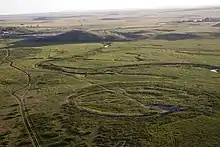 View of the Arkaim site and surrounding landscape
View of the Arkaim site and surrounding landscape Sintashta ceramics and horse bridle cheekpieces
Sintashta ceramics and horse bridle cheekpieces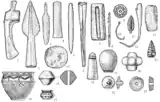 Sintashta culture artefacts
Sintashta culture artefacts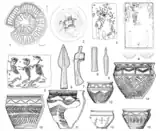 Sintashta culture artefacts
Sintashta culture artefacts Arkaim and Sintashta settlement ground plans
Arkaim and Sintashta settlement ground plans
Genetics

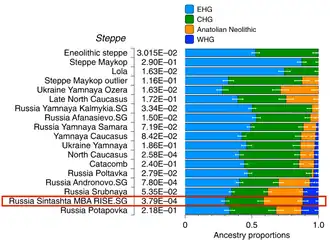
Allentoft 2015 analyzed the remains of four individuals ascribed to the Sintastha culture. One male carried Y-haplogroup R1a and mt-J1c1b1a, while the other carried Y-R1a1a1b and mt-J2b1a2a. The two females carried U2e1e and U2e1h respectively.[18][44] The study found a close autosomal genetic relationship between peoples of Corded Ware culture and Sintashta culture, which "suggests similar genetic sources of the two," and may imply that "the Sintashta derives directly from an eastward migration of Corded Ware peoples."[18] Sintashta individuals and Corded Ware individuals both had a relatively higher ancestry proportion derived from the Central Europe, and both differed markedly in such ancestry from the population of the Yamnaya Culture and most individuals of the Poltavka Culture that preceded Sintashta in the same geographic region.[lower-alpha 2] Individuals from the Bell Beaker culture, the Unetice culture and contemporary Scandinavian cultures were also found to be closely genetically related to Corded Ware. A particularly high lactose tolerance was found among Corded Ware and the closely related Nordic Bronze Age. In addition, the study found samples from the Sintashta culture to be closely genetically related to the succeeding Andronovo culture.
.png.webp)
Narasimhan 2019 analyzed the remains of several individuals associated with the Sintashta culture. mtDNA was extracted from two females buried at the Petrovka settlement. They were found to be carrying subclades of U2 and U5. The remains of fifty individuals from the fortified Sintastha settlement of Kamennyi Ambar was analyzed. This was the largest sample of ancient DNA ever sampled from a single site. The Y-DNA from thirty males was extracted. Eighteen carried R1a and various subclades of it (particularly subclades of R1a1a1), five carried subclades of R1b (particularly subclades of R1b1a1a), two carried Q1a and a subclade of it, one carried I2a1a1a, and four carried unspecified R1 clades. The majority of mtDNA samples belonged to various subclades of U, while W, J, T, H and K also occurred. A Sintashta male buried at Samara was found to be carrying R1b1a1a2 and J1c1b1a. The authors of the study found the majority of Sintashta people (ca. 80%) to be closely genetically related to the people of the Corded Ware culture, the Srubnaya culture, the Potapovka culture, and the Andronovo culture. These were found to harbor mixed ancestry from the Yamnaya culture and peoples of the Central European Middle Neolithic, like the Globular Amphora culture. The remaining sampled Sintashta individuals belonged to various ancestral types different from the majority population, with affinities to earlier populations such as Eneolithic samples collected at Khvalynsk and hunter-gatherers from Tyumen Oblast in western Siberia. This indicates that the Sintashta settlement of Kamennyi Ambar was a cosmopolitan site that united a genetically heterogenous population in a single social group.[50][51]
Horse genetics
The dispersal of the DOM2 genetic lineage, believed to be the ancestor of all modern domesticated horses, is linked with the populations which preceded the Sintashta culture and their expansions. A genetic study published in 2021 suggests that these horses were selectively bred for desired traits including docility, stress tolerance, endurance running, and higher weight-carrying thresholds.[52]
See also
.png.webp)
Notes
- /sɪnˈtɑːʃtə/; Russian: Синташтинская культура, romanized: Sintashtínskaya kultúra, pronounced [sʲɪntɐʂˈtʲinskəjə kʊlʲˈturə]
- Allentoft et al. (2015) analysed ancient DNA recovered from remains at four Sintashta sites. The five samples analysed included the mitochondrial DNA haplogroups U2e, J1, J2 and N1a. The two male individuals both belonged to Y-chromosome haplogroup R1a1.[18]
References
- Lindner 2020, p. 362, "The publication of new radiocarbon data series from selected burial sites in the South-eastern Urals has helped to establish a much more accurate chronology for the late Middle Bronze Age Sintashta-Petrovka complex".
- Lindner 2020, p. 362.
- Koryakova 1998b
- Mallory & Mair 2008, p. 261.
- Anthony 2007, pp. 408–411
- Rowlett, Ralph M. "Research Directions in Early Indo-European Archaeology." (1990): 415-418.
- Heggarty, Paul. "Prehistory by Bayesian phylogenetics? The state of the art on Indo-European origins." Antiquity 88.340 (2014): 566-577.
- Schmitt 1987: "The name Aryan is the self designation of the peoples of Ancient India and Ancient Iran who spoke Aryan languages, in contrast to the 'non-Aryan' peoples of those 'Aryan' countries."
- Anthony 2007, p. 408.
- Chechushkov, I.V.; Epimakhov, A.V. (2018). "Eurasian Steppe Chariots and Social Complexity During the Bronze Age". Journal of World Prehistory. 31 (4): 435–483. doi:10.1007/s10963-018-9124-0. S2CID 254743380.
- Raulwing, Peter (2000). Horses, Chariots and Indo-Europeans – Foundations and Methods of Chariotry Research from the Viewpoint of Comparative Indo-European Linguistics. Archaeolingua Alapítvány, Budapest. ISBN 9789638046260.
- Anthony 2007, p. 402, "Eight radiocarbon dates have been obtained from five Sintashta culture graves containing the impressions of spoked wheels, including three at Sintashta (SM cemetery, gr. 5, 19, 28), one at Krivoe Ozero (k. 9, gr. 1), and one at Kammeny Ambar 5 (k. 2, gr. 8). Three of these (3760 ± 120 BP, 3740 ± 50 BP, and 3700 ± 60 BP), with probability distributions that fall predominantly before 2000 BCE, suggest that the earliest chariots probably appeared in the steppes before 2000 BCE (table 15.1 [p. 376]).".
- Holm, Hans J. J. G. (2019): The Earliest Wheel Finds, their Archeology and Indo-European Terminology in Time and Space, and Early Migrations around the Caucasus. Series Minor 43. Budapest: ARCHAEOLINGUA ALAPÍTVÁNY. ISBN 978-615-5766-30-5
- Hanks & Linduff 2009.
- Semyan, Ivan, and Spyros Bakas, (2021). "Archaeological Experiment on Reconstruction of the 'Compound' Bow of the Sintashta Bronze Age Culture from the Stepnoe Cemetery", in EXARC Journal Issue 2021/2, Introduction.
- Koryakova 1998a.
- Allentoft 2015.
- Narasimhan 2019, Supplementary Information, p. 62: "Morphological data has been interpreted as suggesting that both Fedorovka and Alakul' skeletons are similar to Sintashta groups, which in turn may reflect admixture of Neolithic forest HGs and steppe pastoralists, descendants of the Catacomb and Poltavka cultures.".
- Anthony 2007, pp. 390–391
- Anthony 2007, pp. 386–388.
- Chernykh, E. N., (2009). "Formation of the Eurasian Steppe Belt Cultures: Viewed Through the Lens of Archaeometallurgy and Radiocarbon Dating", in: B. Hanks & K. Linduff (eds.), Social Complexity in Prehistoric Eurasia: Monuments, Metals and Mobility, Cambridge University Press, pp. 132–136.
- Grigoriev, Stanislav, (2021). "Andronovo Problem: Studies of Cultural Genesis in the Eurasian Bronze Age", in Open Archaeology 2021 (7), p.27: Five AMS dates for Petrovka culture are "within the range 1880-1750 BC...", these are dates of two sites, Ustye and Kulevchi (Molodin et al., 2014, p.142), "which are located on the territory of Sintashta culture..."
- Degtyareva, A.D., and S.V. Kuzminykh, (2022). "Metal tools of the Petrovka Culture of the Southern Trans-Urals and Middle Tobol: chemical and metallurgical characteristics", Сетевое издание № 4 (59), December 2022, Abstract: "...Recently introduced in the scientific discourse 27 AMS 14C dates (settlement of Stepnoe and burial grounds of Stepnoe 1, 7 and 25) established an earlier interval of the Petrovka series — 2133–1631 BCE and point to the synchroneity of the cultures at the northern periphery of the Sintashta area in the local microregion of the Southern Trans-Urals."
- Lindner 2020, p. 364, "Indeed, a new radiocarbon series has confirmed the position of the Petrovka stage in the nineteenth to eighteenth centuries BC (Krause et al. 2019). Recent research at the enclosed settlement of Kamennyj Ambar in the Karagajly Ajat River valley (Chelyabinsk Oblast) supports this stratigraphic evidence, based on the existence of different occupation phases....".
- Lindner 2020, p. 367.
- Ventresca Miller, Alicia R., et al., (2020 b). "Ecosystems Engineering Among Ancient Pastoralists in Northern Central Asia", in Frontiers in Earth Science, Volume 8, Article 168, 2 June 2020, p. 6: "...Middle Bronze Age (2400–1800 cal BCE) people, often referred to as Sintashta, constructed nucleated settlements, with population estimates ranging from 200 to 700 individuals..."
- Ventresca Miller, A. R., et al., (2020 a). "Close management of sheep in ancient Central Asia: evidence for foddering, transhumance, and extended lambing seasons during the Bronze and Iron Ages", in STAR, Science & Technology of Archaeological Research, p. 2.
- Allentoft 2015, Supplementary Information, p. 5: "There are many similarities between Sintasthta/Androvono rituals and those described in the Rig Veda and such similarities even extend as far as to the Nordic Bronze Age.".
- "Early Indo-Iranic loans in Uralic: Sounds and strata" (PDF). Martin Joachim Kümmel, Seminar for Indo-European Studies.
- Kuzmina 2007, p. 222.
- Anthony 2007.
- Beckwith 2009.
- Anthony 2007, pp. 383–384
- Rawson, Jessica (Autumn 2015). "Steppe Weapons in Ancient China and the Role of Hand-to-hand Combat". The National Palace Museum Research Quarterly. 33 (1): 49: See reference 33 – E. N. Chernykh, Ancient Metallurgy in the USSR, The Early Metal Age, 225, fig. 78.
{{cite journal}}: CS1 maint: postscript (link) - Bersenev, Andrey; Epimakhov, Andrey; Zdanovich, Dmitry (2011). "Bow and arrow. The Sintasha bow of the Bronze Age of the south Trans-Urals, Russia". In Marion Uckelmann; Marianne Modlinger; Steven Matthews (eds.). Bronze Age Warfare: Manufacture and Use of Weaponry. European Association of Archaeologists. Annual Meeting. Archaeopress. pp. 175–186. ISBN 978-1-4073-0822-7.
- Librado, P., Khan, N., Fages, A. et al. The origins and spread of domestic horses from the Western Eurasian steppes. Nature 598, 634–640 (2021). https://doi.org/10.1038/s41586-021-04018-9
- "Metal-Production, Mortuary Ritual, and Social Identity: The Evidence of Sintashta Burials, Southern Urals". Retrieved 2022-11-02.
- Anthony 2007, p. 391.
- Anthony 2007, pp. 435–418.
- Gibbons, Ann (10 June 2015). "Nomadic herders left a strong genetic mark on Europeans and Asians". Science. AAAS.
- Narasimhan, Vagheesh M.; Patterson, Nick; Moorjani, Priya (6 September 2019). "The formation of human populations in South and Central Asia". Science. 365 (6457). doi:10.1126/science.aat7487. ISSN 0036-8075.
- Wang, Chuan-Chao; Reinhold, Sabine; Kalmykov, Alexey (4 February 2019). "Ancient human genome-wide data from a 3000-year interval in the Caucasus corresponds with eco-geographic regions". Nature Communications. 10 (1): 590. Bibcode:2019NatCo..10..590W. doi:10.1038/s41467-018-08220-8. ISSN 2041-1723. PMC 6360191. PMID 30713341.
- Mathieson 2015.
- Narasimhan 2019, p. 7: "Our analysis of 50 individuals from the Sintashta culture cemetery of Kamennyi Ambar 5 reveals multiple groups of outliers that we directly radiocarbon dated to be contemporaries of the main cluster but that were also genetically distinctive, indicating that this was a cosmopolitan site".
- Librado, Pablo; Khan, Naveed; Fages, Antoine; Kusliy, Mariya A.; Suchan, Tomasz; Tonasso-Calvière, Laure; Schiavinato, Stéphanie; Alioglu, Duha; Fromentier, Aurore; Perdereau, Aude; Aury, Jean-Marc (2021). "The origins and spread of domestic horses from the Western Eurasian steppes". Nature. 598 (7882): 634–640. Bibcode:2021Natur.598..634L. doi:10.1038/s41586-021-04018-9. ISSN 1476-4687. PMC 8550961. PMID 34671162.
- Jeong, Choongwon; Wang, Ke; Wilkin, Shevan (12 November 2020). "A Dynamic 6,000-Year Genetic History of Eurasia's Eastern Steppe". Cell. 183 (4): 890–904, Figure 1 A, B, C. doi:10.1016/j.cell.2020.10.015. ISSN 0092-8674.
- Török, Tibor (July 2023). "Integrating Linguistic, Archaeological and Genetic Perspectives Unfold the Origin of Ugrians". Genes. 14 (7): Figure 1. doi:10.3390/genes14071345. ISSN 2073-4425.
Sources
- Anthony, David W. (2007). The Horse, the Wheel, and Language. Princeton, NJ: Princeton University Press. ISBN 978-0-691-05887-0.
- Allentoft, ME (June 11, 2015). "Population genomics of Bronze Age Eurasia". Nature. Nature Research. 522 (7555): 167–172. Bibcode:2015Natur.522..167A. doi:10.1038/nature14507. PMID 26062507. S2CID 4399103.
- Anthony, D. W. (2009). "The Sintashta Genesis: The Roles of Climate Change, Warfare, and Long-Distance Trade". In Hanks, B.; Linduff, K. (eds.). Social Complexity in Prehistoric Eurasia: Monuments, Metals, and Mobility. Cambridge University Press. pp. 47–73. doi:10.1017/CBO9780511605376.005. ISBN 978-0-511-60537-6.
- Beckwith, Christopher I. (2009), Empires of the Silk Road, Princeton University Press
- Hanks, B.; Linduff, K. (2009). "Late Prehistoric Mining, Metallurgy, and Social Organization in North Central Eurasia". In Hanks, B.; Linduff, K. (eds.). Social Complexity in Prehistoric Eurasia: Monuments, Metals, and Mobility. Cambridge University Press. pp. 146–167. doi:10.1017/CBO9780511605376.005. ISBN 978-0-511-60537-6.
- Koryakova, L. (1998a). "Sintashta-Arkaim Culture". The Center for the Study of the Eurasian Nomads (CSEN). Archived from the original on 28 February 2019. Retrieved 16 September 2010.
- Koryakova, L. (1998b). "An Overview of the Andronovo Culture: Late Bronze Age Indo-Iranians in Central Asia". The Center for the Study of the Eurasian Nomads (CSEN). Archived from the original on 28 February 2019. Retrieved 16 September 2010.
- Kuznetsov, P. F. (2006). "The emergence of Bronze Age chariots in eastern Europe". Antiquity. 80 (309): 638–645. doi:10.1017/S0003598X00094096. S2CID 162580424. Archived from the original on 2012-07-07.
- Kuzmina, Elena E. (2007). Mallory, J. P. (ed.). The Origin of the Indo-Iranians. BRILL. ISBN 978-9004160545.
- Lindner, Stephan (2020). "Chariots in the Eurasian Steppe: a Bayesian approach to the emergence of horse-drawn transport in the early second millennium BC". Antiquity. 94 (374): 361–380. doi:10.15184/aqy.2020.37. ISSN 0003-598X.
- Mallory, J. P.; Mair, Victor H. (2008). The Tarim Mummies: Ancient China and the Mystery of the Earliest Peoples from the West. Thames & Hudson. ISBN 9780500283721.
- Mathieson, Iain (November 23, 2015). "Genome-wide patterns of selection in 230 ancient Eurasians". Nature. Nature Research. 528 (7583): 499–503. Bibcode:2015Natur.528..499M. doi:10.1038/nature16152. PMC 4918750. PMID 26595274.
- Narasimhan, Vagheesh M. (September 6, 2019). "The formation of human populations in South and Central Asia". Science. American Association for the Advancement of Science. 365 (6457): eaat7487. bioRxiv 10.1101/292581. doi:10.1126/science.aat7487. PMC 6822619. PMID 31488661.
- Tkachev, Vitaly V. (June 29, 2020). "Radiocarbon Chronology of the Sintashta Culture Sites in the Steppe Cis-Urals". Russian Archaeology (2): 31–44. doi:10.31857/S086960630009071-7.
Further reading
- Vasil'ev, I. B., P. F. Kuznetsov, and A. P. Semenova. "Potapovo Burial Ground of the Indo-Iranic Tribes on the Volga" (1994).
External links
- Stanislav A. Grigoriev, "Ancient Indo-Europeans" ISBN 5-88521-151-5